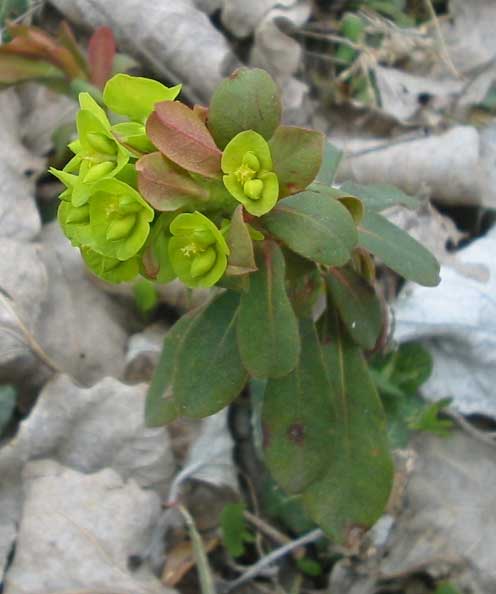
Euphorbia amygdaloides (*)
Classification System: APG IV
Superregnum: Eukaryota
Regnum: Plantae
Cladus: Angiosperms
Cladus: Eudicots
Cladus: Core eudicots
Cladus: Rosids
Cladus: Eurosids I
Ordo: Malpighiales
Familia: Euphorbiaceae
Subfamilia: Euphorbioideae
Tribus: Euphorbieae
Subtribus: Euphorbiinae
Genus: Euphorbia
Subgenus: E. subg. Esula
Sectio: E. sect. Patellares
Species: Euphorbia amygdaloides
Subspecies: E. a. subsp. amygdaloides – E. a. subsp. robbiae
Name
Euphorbia amygdaloides L., 1753
Synonyms
Homotypic
Tithymalus amygdaloides (L.) Garsault, Fig. Pl. Méd.: 594 (1764), opus utique oppr.
Euphorbia nemoralis Salisb., Prodr. Stirp. Chap. Allerton: 390 (1796), nom. superfl.
Esula amygdaloides (L.) Haw., Syn. Pl. Succ.: 154 (1812).
Characias amygdaloides (L.) Gray, Nat. Arr. Brit. Pl. 2: 260 (1821 publ. 1822).
Homonyms
Euphorbia amygdaloides Lam., nom. illeg. = Euphorbia nicaeensis subsp. nicaeensis
Distribution
Native distribution areas:
Continental: Eurasia
Regional: Medit., Europe to C. Asia
Albania; Austria; Belarus; Belgium; Bulgaria; Corse; Czechoslovakia; France; Germany; Great Britain; Greece; Hungary; Iran; Ireland; Italy; Kriti; Krym; Netherlands; North Caucasus; Poland; Portugal; Romania; Sardegna; Sicilia; Spain; Switzerland; Transcaucasus; Turkey; Turkey-in-Europe; Ukraine; Yugoslavia
Continental: Africa
Regional: Northern Africa
Algeria; Tunisia
References: Brummitt, R.K. 2001. TDWG – World Geographical Scheme for Recording Plant Distributions, 2nd Edition
References
Primary references
Linnaeus, C. 1753. Species plantarum, exhibentes plantas rite cognitas, ad genera relatas, cum differentiis specificis, nominibus trivialibus, synonymis selectis, locis natalibus, secundum systema sexuale digestas. Tomus I. Pp. [I–XII], 1–560. Impensis Laurentii Salvii, Holmiae [Stockholm]. BHL Reference page. : 463.
Links
Govaerts, R. et al. 2020. Euphorbia amygdaloides in World Checklist of Selected Plant Families. The Board of Trustees of the Royal Botanic Gardens, Kew. Published on the internet. Accessed: 2020 Jun 19. Reference page.
International Plant Names Index. 2020. Euphorbia amygdaloides. Published online. Accessed: Jun 19 2020.
Govaerts, R. et al. 2020. Euphorbia amygdaloides in Kew Science Plants of the World online. The Board of Trustees of the Royal Botanic Gardens, Kew. Published on the internet. Accessed: 2020 Jun 19. Reference page.
Tropicos.org 2020. Euphorbia amygdaloides. Missouri Botanical Garden. Published on the internet. Accessed: 2020 Jun 19.
USDA, ARS, Germplasm Resources Information Network. Euphorbia amygdaloides in the Germplasm Resources Information Network (GRIN), U.S. Department of Agriculture Agricultural Research Service. Accessed: 08-Apr-12.
Vernacular names
català: Lleteresa de bosc
čeština: Pryšec mandloňovitý
Deutsch: Mandelblättrige Wolfsmilch
dolnoserbski: Mandlowe wjelkowe mloko
English: Wood Spurge
español: Titímalo macho
suomi: Mantelityräkki
français: Euphorbe des bois
hornjoserbsce: Mandlowa mlóčeń
magyar: Erdei kutyatej
italiano: Euforbia delle Faggete
Nederlands: Amandelwolfsmelk
polski: Wilczomlecz migdałolistny
русский: Молочай миндалевидный
slovenčina: Mliečnik mandľovitý
slovenščina: Mandljevolistni mleček
Euphorbia amygdaloides, the wood spurge, is a species of flowering plant in the family Euphorbiaceae, native to woodland locations in Europe, Turkey and the Caucasus. It is a bushy evergreen perennial, growing to a height of 80 cm (31 in), with dark green slightly hairy leaves about 6 cm (2 in) long. The complex green-yellow inflorescence (cyathium), typical of Euphorbia, appears in late spring and early summer.[1]
It is among the few plants that thrive in the dry shade of trees, where it is used as groundcover. It spreads rapidly by underground rhizomes and can become invasive, though relatively easy to remove.[1]
One form known is Euphorbia ‘Efanthia’.[2] The subspecies E. amygdaloides subsp. robbiae (Turrill) Stace, known as Mrs Robb's bonnet, is grown as a garden plant, and has gained the Royal Horticultural Society’s Award of Garden Merit.[3][4]
The milky latex of the plant is toxic and can cause irritation on contact with the skin.
References
RHS A-Z encyclopedia of garden plants. United Kingdom: Dorling Kindersley. 2008. p. 1136. ISBN 978-1405332965.
"Euphorbia 'Efanthia'". dorsetperennials.co.uk. Retrieved 29 January 2017.
"Euphorbia amygdaloides var. robbiae, Mrs Robb's bonnet". Royal Horticultural Society. Retrieved 7 April 2017.
"AGM Plants - Ornamental" (PDF). Royal Horticultural Society. July 2017. p. 38. Retrieved 26 February 2018.
Retrieved from "http://en.wikipedia.org/"
All text is available under the terms of the GNU Free Documentation License

